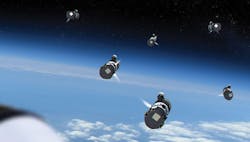Three defense companies to develop ballistic missile defense multi-warhead killer
HUNTSVILLE, Ala. - U.S. missile defense experts are moving forward with three U.S. prime defense contractors to develop a future ballistic missile defense multi-warhead killer intended to detect, track, and kill several different incoming enemy missile warheads and decoys with only one counter-missile launch.
Officials of the U.S. Missile Defense Agency (MDA) in Huntsville, Ala., are asking systems designers at the Boeing Co., Raytheon Co., and Lockheed Martin Corp. for technology work related to the Multi-Object Kill Vehicle (MOKV) technology risk reduction effort.
The MOKV is to engage several incoming objects simultaneously with kill vehicles that communicate with one another and destroy several incoming warheads and decoys using advanced sensor, divert and attitude control, and communications technologies.
MDA officials announced a $58.6 million contract to the Boeing Defense, Space & Security segment in Huntsville, Ala., for the MOKV technology risk reduction effort. The Raytheon Missile Systems segment in Tucson, Ariz., won a $59.6 million contract, and the Lockheed Martin Space Systems segment in Sunnyvale, Calif., won a $53.1 million contract for MOKV technology risk reduction.
Now the three companies proceed to the next stage of MOKV development, which attempts to improve performance and reduce risk for MOKV advanced communications, engagement management, and the system's discriminating seeker.
Raytheon, Lockheed Martin, and Boeing also won MDA contracts in 2015 to define MOKV proof-of-concept prototypes, demonstrate risk mitigation steps, assess the technical maturity of their concepts, and rank enabling technologies to minimize design risks.
MDA officials ultimately are expected to narrow the field to one contractor for advanced development and manufacturing for the MOKV program.
The MDA's ground-based interceptor missile today carries one kill warhead that detects, tracks, and attacks an incoming enemy ballistic missile warhead and attempts to destroy it kinetically by force of impact. The MOKV, instead, is expected to launch on one air-defense missile, and deploy several kill vehicles that could engage several incoming enemy warheads. MOKV warheads will be designed to communicate with one another to coordinate their attacks.
As many as six MOKVs will launch on one booster rocket, deploy at the edge of space, steer toward, and destroy several incoming ballistic missile warheads and decoys using separate kinetic hit-to-kill weapons.
The MOKV would function similarly to the MDA's Multiple Kill Vehicle (MKV) program, which was cancelled in 2009. The MOKV is likely to launch on rockets like the U.S. Navy Raytheon SM-3 standard shipboard missile. When put to use, military forces will load several MOKVs on one missile-defense rocket, such as the three-stage Ground-Based Interceptor (GBI). After launch, each MOKV will steer toward an incoming ballistic missile warhead or decoy to destroy it.
Each interceptor rocket will have an advanced sensor and divert, attitude-control, and communications technologies, to enable each MOKV to home-in on its target. Each MOKV will have its own sensor and diverting thrusters.
If MDA officials and other senior military leaders decide to proceed with MOKV development, production of these sophisticated missile-defense warheads could begin in 2022.
On the MOKV contract, Boeing will do the work in Huntsville, Ala. On the two previous MOKV technology risk-reduction contracts, Raytheon will do the work in Tucson, Ariz., and Lockheed Martin will do the work in Sunnyvale and Goleta, Calif., and in Bethesda, Md. The three companies should be finished with this phase of MOKV development by spring 2020.
FOR MORE INFORMATION visit Boeing Defense, Space & Security online at www.boeing.com/defense, Raytheon Missile Systems at www.raytheon.com, and Lockheed Martin Space Systems at www.lockheedmartin.com/us/ssc.html.

